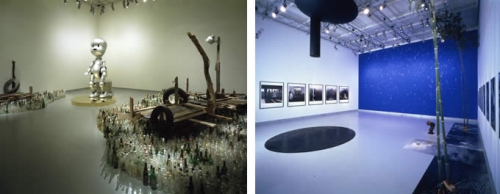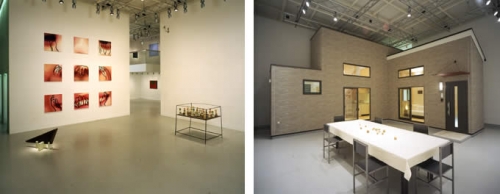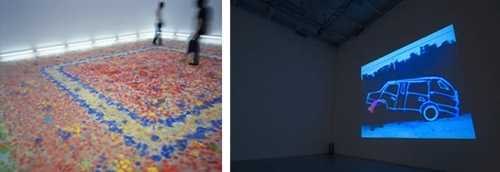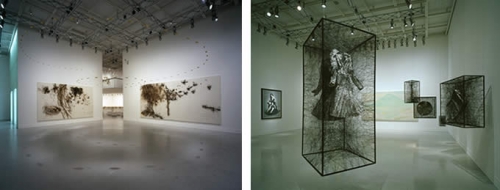Continually pursuing new images of beauty
Shiseido has continually pursued new images of beauty that are ahead of the times. As a pioneer of corporate support of the arts in this country, over the years it has taken on part of the responsibility for supporting the Japanese contemporary art world. We explore the roots of Shiseido’s activities in support of the arts by looking at the history of the Shiseido Gallery, which is central to the company’s activities in this field.
Research/text: ART iT
History of the Shiseido Gallery
The Shiseido Gallery, which opened in Ginza in 1919, is the oldest existing gallery in Japan. Consistent with the aims of the first company president, Fukuhara Shinzo, who was also a photographer, in establishing the gallery, which included “wanting to give young artists the opportunity to launch forth in life by providing them with exhibition space free-of-charge”, the gallery long maintained the style of a rental gallery. At the same time, it has also organized countless shows of its own over the years, including the Tsubaki-kai group exhibitions, first held in 1947 and continuing to this day, and the Modern Crafts exhibitions (1975 – 95), which introduced contemporaneous craftspeople. In 1975 Shiseido opened the Ginza Art Hall (later renamed the Ginza Art Space, until 2000), which focused on photography, fashion, and other subcultures, and it later established the Shiseido Art House (1978 -, Kakegawa), which houses and displays a collection that includes works from the Tsubaki-kai and Modern Crafts exhibitions, marking a broadening of the company’s activities in support of art and culture.
Returning to its starting point
It was in the context of this course of events that in 1990 the company established its Corporate Culture Department, and the handover of the gallery to this department from the Advertising Department was used as an opportunity to review thoroughly the company’s policy with regard to the gallery’s operation.
“Until then the image of the Shiseido Gallery was of a place frequented by artists wearing berets and bolo ties. As they notched up one successful exhibition after another, artists who started out as newcomers became the mainstay of the art world, and the gallery turned into a place where prominent figures from various art associations displayed their work.”
Higuchi Masaki, who has been involved in gallery planning and support activities within the Corporate Culture Department since 1992, describes the situation during this transitional period.
“So we decided to go back to the starting point and concentrate on introducing contemporary art mainly by young artists. When we actually held an exhibition of contemporary art, the reaction from those around us was one of surprise, so we had to explain that it wasn’t a change of direction but a return to our starting point.”
Up to that time, recognized masters such as Umehara Ryuzaburo, Oka Shikanosuke, and Uemura Shoko had been chosen as members of the Tsubaki-kai, but beginning with the fourth exhibition in 1993, there was a shift to post-war contemporary artists such as Lee U-fan and Funakoshi Katsura.
“Looking back now, many members of that fourth Tsubaki-kai group also became leading figures in the Japanese contemporary art world. Considering that Lee U-Fan of Mono-ha and Hori Kosai of Bikyoto (Artists Joint Struggle Council), who represented the next generation, were both included in the lineup, one could almost say it covered the entire history of Japanese post-war contemporary art. This changed as time went on, with the fifth and sixth exhibitions focusing more on artists who were active contemporaneously.”
When the gallery reopened in 2001 following extensive renovations, the three basic policies of “carrying on traditions while encouraging innovation in tune with the times”, “holding international scale exhibitions befitting the global era” and “introducing new currents in art” were adopted, and programs put together on the basis of these policies. As well, from this time onwards the gallery ceased operating as a rental space, hosting only exhibitions it had organized itself.
“Starting with 1994’s Promenade in Asia, we’ve continued introducing intermittently Asian artists, and we’re planning a Kimsooja show for autumn this year. One of our aims is to give artists the support that enables them to step up a level, so we’ve concentrated on young artists whose prospects are bright. As well, we’ve put a lot of effort into being the first to introduce in Japan artists who are hot overseas. There are instances where public art museums, as social educational institutions, can’t introduce artists until they’re been recognized to a certain extent, so in this regard we’d like to make the most of the flexibility we enjoy as a private gallery.”
As a pioneer in corporate support of the arts
In recognition of these and other activities, Shiseido was awarded the Mecenat Grand Prize at the 2007 Japan Mecenat Awards sponsored by the Association for Corporate Support of the Arts, Japan.
“There’s a growing trend in corporate activities in support of the arts towards restricting support to corporate-initiated programs such as art NPOs and awards, but in Shiseido’s case we place importance on supporting directly artists’ activities themselves.”
In the case of artists like Cai Guo-Qiang and Ohmaki Shinji, for example, Shiseido has continued to support them whenever they take part in a major exhibition or international show right from the early stage of their careers through to the present. Then there was ADSP (Art Documents Support Program by Shiseido), which helped young artists create catalogs, an initiative that was without parallel when it was launched in 2000.
“When we compiled 75 years of the Shiseido Gallery in 1995, we felt strongly the need to record the activities of artists for the benefit of future generations. ADSP didn’t simply give out money; it was a program that provided editing know-how and worked together with artists in creating their catalogs. The artists themselves were responsible for organizing photographers and people to write reviews. I think the most valuable thing about this program was that in the process it enabled artists to learn the importance of creating their own documents.”
ADSP was wound up in 2005, having enjoyed a favorable reception, and in 2007 the company launched shiseido art egg, a public exhibition series that throws open the doors of the Shiseido Gallery to up-and-coming artists whose work cannot be covered adequately in regular exhibitions alone. Three artists selected by gallery advisors, curatorial staff, and other experts are each given the opportunity to exhibit their work for three weeks. At the end of the three-month exhibition period, one of the artists is awarded the shiseido art egg prize.
“The most important thing is that the selected artists spend six months preparing their exhibitions, talking things over one-on-one with the curatorial staff, and occasionally having faults pointed out to them, and in the process improve their skill levels. I think things like the ability to self-produce and knowledge of the various techniques for presenting their work are all part of an artist’s creative capability. Because we want the artists to improve their skills, including these capabilities, it’s not the prize that’s important. The point is the degree to which we can support the artists’ growth.”
In light of Shiseido’s track record as a company that continually pursues state-of-the-art beauty and creates new value through products, its cultural support initiatives could be described as forming part of its core activities. Plans for the future include seeking out ways of providing even stronger support by mutually connecting gallery projects and other support activities. This earnest approach is heightening expectations with regard to future innovative activities.
Shiseido Gallery
http://www.shiseido.co.jp/gallery

Left: ex-, 2001
Right: Promenade in Asia, 2001
Installation views, photos Sakuai Tadahisa

Left: life/art ’02, 2002
Right: Koganezawa Takehito, Dancing In Your Head, 2004
Installation views, photos Sakuai Tadahisa

Left: Ohmaki Shinji, ECHOES INFINITY, 2005
Installation view, photo Watabe Ryoji
Right: Robin Rhode, 2006
Installation view, photo Kato Takeshi

Left: Light Passage – Cai Guo-Qiang & Shiseido, 2007
Right: Tsubaki-kai 2008
Installation views, photo Yamamoto Tadasu
Posted: 2008.8.8
